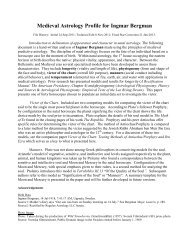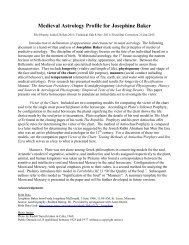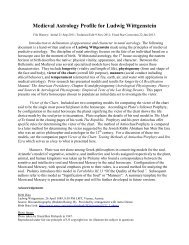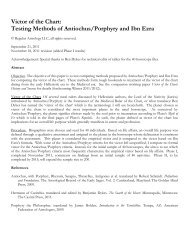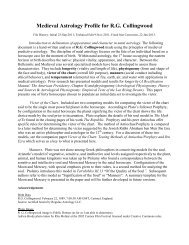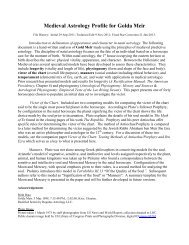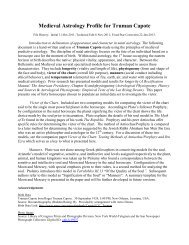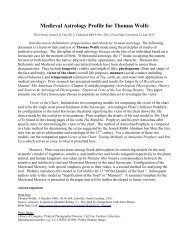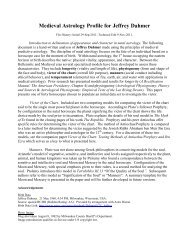Working Paper on Astrological Physiognomy: History and Sources
Working Paper on Astrological Physiognomy: History and Sources
Working Paper on Astrological Physiognomy: History and Sources
Create successful ePaper yourself
Turn your PDF publications into a flip-book with our unique Google optimized e-Paper software.
<str<strong>on</strong>g>Working</str<strong>on</strong>g> <str<strong>on</strong>g>Paper</str<strong>on</strong>g> <strong>on</strong> <strong>Astrological</strong> <strong>Physiognomy</strong>: <strong>History</strong> <strong>and</strong> <strong>Sources</strong><br />
judge which parent the native most resembles in physical appearance using Abu Bakr as a<br />
source. Of the four authors, Ibn Ezra offers the most complete set of surviving decan-based rules.<br />
In additi<strong>on</strong> to including descriptive decan language in the magical traditi<strong>on</strong>, Ibn Ezra menti<strong>on</strong>s<br />
both Chaldean <strong>and</strong> Hindu systems. In a departure from other texts, he proceeds to delineate<br />
decan-based physiognomy rules based <strong>on</strong> the Hindu system, the first astrological author I have<br />
seen do so. 27 Nevertheless, Ibn Ezra’s use of the Hindu decans was not st<strong>and</strong>ard practice am<strong>on</strong>g<br />
medieval <strong>and</strong> early modern astrologers. Not until Alan Leo returned from his trips to India in the<br />
early 20 th century were the Hindu decans revived within the western astrological traditi<strong>on</strong> in any<br />
meaningful fashi<strong>on</strong>. Finally, as an odd twist to the st<strong>and</strong>ard three-fold sign subdivisi<strong>on</strong> decan<br />
system, Wiliam Salm<strong>on</strong> (1644-1713) introduced an entirely new set of decans based <strong>on</strong> a sixfold<br />
sign subdivisi<strong>on</strong> scheme. Salm<strong>on</strong>’s system was taken up later by Simm<strong>on</strong>ite, published in<br />
his late Victorian textbook <strong>on</strong> natal astrology Complete Arcana (1890).<br />
Dwads, or the 12 th part of signs, are related to decans because signs for the 1 st , 5 th <strong>and</strong> 9 th<br />
dwads of each 30 degree zodiacal sign are identical to the signs for the 1 st , 2 nd , <strong>and</strong> 3 rd decan of<br />
the same sign. Said another way, dwads can be c<strong>on</strong>sidered a fractal of all zodiac signs replicated<br />
within a single zodiac sign. Likewise, decans can be c<strong>on</strong>sidered a fractal of all zodiac signs with<br />
the same triplicity within a single zodiac sign.<br />
Table 4. Fractal linkage between Decans <strong>and</strong> Dwads for the sign of Aries.<br />
Zodiacal Degree Decan Dwad<br />
0AR00 – 2AR29 Aries Aries<br />
2AR30 – 4AR59 Aries Taurus<br />
5AR00 – 7AR29 Aries Gemini<br />
7AR30 – 9AR59 Aries Cancer<br />
10AR00 – 12AR29 Leo Leo<br />
12AR30 – 14AR59 Leo Virgo<br />
15AR00 – 17AR29 Leo Libra<br />
17AR30 – 19AR59 Leo Scorpio<br />
20AR00 – 22AR29 Sagittarius Sagittarius<br />
22AR30 – 24AR59 Sagittarius Capricorn<br />
25AR00 – 27AR29 Sagittarius Aquarius<br />
27AR30 – 29AR59 Sagittarius Pisces<br />
The earliest evidence for the use of dwads in physiognomy can be found in <strong>on</strong>e of the Dead<br />
Sea Scrolls. Drawing <strong>on</strong> the Rhetorius-Teucer sign-based rules, Popovic suggests a reference to<br />
the ‘foot of Taurus’ as evidence that individual body parts of the Taurus Bull were assigned to<br />
the 30 degrees of the sign of Taurus based <strong>on</strong> dwad sign subdivisi<strong>on</strong>s. As originally suggested<br />
27 For textual evidence which supports Ibn Ezra’s decan delineati<strong>on</strong>s made using the Hindu system, see for example<br />
the word ‘intelligence’ which appears under the sign Virgo itself (p. 48), the 2 nd decan of Taurus assigned to Virgo<br />
(p. 28-29), <strong>and</strong> in the 3 rd decan of Capricorn assigned to Virgo (p. 67). Al-Biruni may be the source for Ibn Ezra’s<br />
use of Hindu decans which he included in hi Kitab al-tafhim published in 1029 C.E after he returned from India.<br />
©Regulus Astrology LLC, 2010. All Rights Reserved.<br />
17




